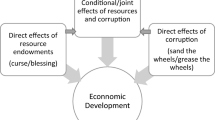Abstract
Natural resource-rich countries shall enjoy better economic growth and socio-economic welfare than those that are less fortunate. Natural resources that have been endowed to these countries should be a genuine source of fortune and happiness. Surprisingly, everyday experiences and empirical studies show the reverse (Frankel, 2010). It seems that natural resource abundance is detrimental to economic growth. This puzzling phenomenon is known as the natural resource curse (NRC) hypothesis. In the past decades it has attracted voluminous research papers that try to empirically show the prevalence of the NRC and at the same time attempt to provide analytical explanations of why the NRC existed in the resource-abundant economies (Sachs & Warner, 1995; Leite & Weidmann, 1999; Gylfason, 2001; Gylfason & Zoega, 2006). In the literature, it is suggested that there are at least three theories explaining the NRC: ‘Dutch disease’ models (Sachs & Warner, 1999), rent-seeking phenomena (Tornell & Lane, 2000), and institutional explanations (Sachs & Warner, 1995, 2001). However, the empirical findings from these studies are still far from conclusive.
Access this chapter
Tax calculation will be finalised at checkout
Purchases are for personal use only
Preview
Unable to display preview. Download preview PDF.
Similar content being viewed by others
References
Atkinson, G. and Hamilton, K. (2003) ‘Savings, Growth and the Resource Curse Hypothesis’. World Development, 31(11), 1793–807.
Belsley, D., Kuh, E. and Welsh, R. (1980) Regression Diagnostics. Wiley: New York.
Bhattacharyya, S. and Hodler, R. (2010) ‘Natural Resources, Democracy and Corruption’, European Economic Review, 54(4), 608–21.
Brunnschweiler, C. N. (2008) ‘Cursing the Blessings? Natural Resource Abundance, Institutions, and Economic Growth’, World Development, 36(3), 399–419.
Brunnschweiler, C. N. and Bulte, E. H. (2008) ‘The Resource Curse Revisited and Revised: A Tale of Paradoxes and Red Herrings’, Journal of Environmental Economics and Management, 55(3), 248–64.
Demetriades, P. and Law, S. (2006) ‘Finance, Institutions and Economic Development’, International Journal of Finance and Economics, 11, 245–60.
Dinda, S. (2004) ‘Environmental Kuznets Curve Hypothesis: A Survey’, Ecological Economics, 49(2004), 431–55.
Frankel, J. (2010) ‘The Natural Resource Curse: A Survey’, Harvard Kennedy School Faculty Research Working Paper Series, RWP10–005.
Fukuyama, F. (2001) ‘Social Capital, Civil Society, and Development’, Third World Quarterly, 22(1), 7–20.
Gleason, K. C., Chun, I. L. and Mathur, I. (2002) ‘Dimensions of International Expansions by US Firms to China: Wealth Effects, Mode Selection, and Firm-Specific Factors’, International Review of Economics and Finance, 11, 139–54.
Guha, A. (1989) ‘Consumption, Efficiency and Surplus Labour’, Journal of Development and Economics, 31(1), 1–12.
Guiso, L., Sapienza, P. and Zingales, L. (2004) ‘The Role of Social Capital in Financial Development’, The American Economic Review, 94, 526–56.
Gylfason, T. (2001) ‘Natural Resources, Education, and Economic Development’, European Economic Review, 45, 847–59.
Gylfason, T. and Zoega, G. (2006) ‘Natural Resources and Economic Growth: The Role of Investment’, The World Economy, 29(8), 1091–115.
Hansen, B. (1996) ‘Inference When a Nuisance Parameter is Not Identified under the Null Hypothesis’, Econometrica, 64, 413–30.
Hansen, B. (2000) ‘Sample Splitting and Threshold Estimation’, Econometrica, 68, 575–603.
Kutan, A. M. and Wyzan, M. L. (2005) ‘Explaining the Real Exchange Rate in Kazakhstan, 1996 to 2003: Is Kazakhstan Vulnerable to the Dutch Disease?’ Economic Systems, 29(2), 242–55.
Larrain, B. (2004) ‘Financial Development, Financial Constraints, and the Volatility of Industrial Output’, Public Policy Discussion Paper 04–6, Federal Reserve Bank of Boston.
Leamer, E. E., Maul, H., Rodriguez, S. and Schott, P. K. (1999) ‘Does Natural Resource Abundance Increase Latin American Income Inequality?’ Journal of Development Economics, 59, 3–42.
Leite, C. A. and J. Weidmann (1999) ‘Does Mother Nature Corrupt? Natural Resources, Corruption, and Economic Growth’, IMF Working Paper No. 99/85, Washington, DC: International Monetary Fund.
Looney, R. E. (1991) ‘Diversification in a Small Oil Exporting Economy: The Impact of the Dutch Disease on Kuwait’s Industrialization’, Resources Policy, 17(1), 31–41.
Narayan, P. K. and Narayan, S (2010) ‘Carbon Dioxide Emissions and Economic Growth: Panel Data Evidence from Developing Countries’, Energy Policy, 38(1), 661–66.
Nili, M. and Rastad, M. (2007) ‘Addressing the Growth Failure of the Oil Economies: The Role of Financial Development’, The Quarterly Review of Economics and Finance, 46(5), 726–40.
Rajan, R. and Zingales, L. (2003) ‘The Great Reversals: The Politics of Financial Development in the 20th Century’, Journal of Financial Economics, 69, 5–50.
Robinson, J. A., Torvik, R. and Verdier, T. (2006) ‘Political Foundations of the Resource Curse’, Journal of Development Economics, 79(2), 447–68.
Sachs, J. D. and Warner, A (1995) ‘Natural Resource Abundance and Economic Growth’, Harvard Institute For International Development, Development Discussion Paper No. 517.
Sachs, J. D. and Warner, A. (1999) ‘The Big Push, Natural Resource Booms and Growth’, Journal of Development Economics, 59, 43–76.
Sachs, J. D. and Warner, A. (2001) ‘Natural Resources and Economic Development: The Curse of Natural Resources’, European Economic Review, 45, 827–38.
Stevens, P. and Dietsche, E. (2008) ‘Resource Curse: An Analysis of Causes, Experiences and Possible Ways Forward’, Energy Policy, 36(1), 56–65.
Tornell, A. and Lane, P. R. (1999) ‘The Voracity Effect’, American Economic Review, 89, 22–46.
van der Ploeg, F. and Poelhekke, S. (2010) ‘The Pungent Smell of “Red Herrings”: Subsoil Assets, Rents, Volatility and the Resource Curse’, Journal of Environmental Economics and Management, 60(1), 44–55.
World Bank (2008) World Development Indicators 2008, Washington DC.
Yuxiang, K. and Chen, Z. (2010) ‘Resource Abundance and Financial Development: Evidence from China’, Resources Policy, In press, corrected proof.
Editor information
Editors and Affiliations
Copyright information
© 2013 Tamat Sarmidi, Siong-Hook Law and Norlida Hanim Mohd Salleh
About this chapter
Cite this chapter
Sarmidi, T., Law, SH., Salleh, N.H.M. (2013). Resource Curses Finance. Can Humans Stop It?. In: Hooy, CW., Ali, R., Rhee, S.G. (eds) Emerging Markets and Financial Resilience. Palgrave Macmillan, London. https://doi.org/10.1057/9781137266613_3
Download citation
DOI: https://doi.org/10.1057/9781137266613_3
Publisher Name: Palgrave Macmillan, London
Print ISBN: 978-1-349-44319-2
Online ISBN: 978-1-137-26661-3
eBook Packages: Palgrave Economics & Finance CollectionEconomics and Finance (R0)




